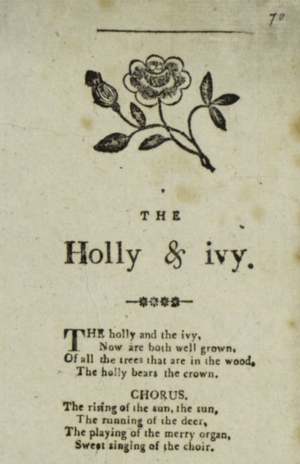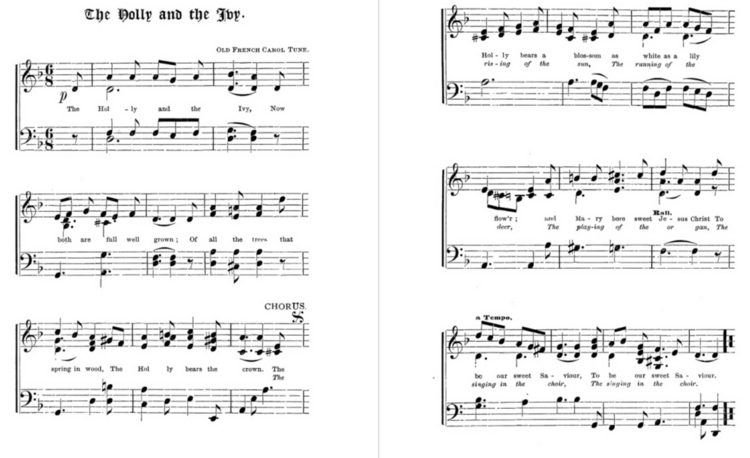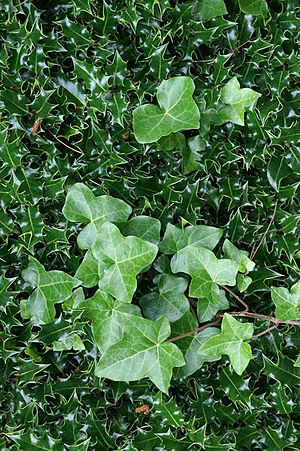The Holly and the Ivy facts for kids
Quick facts for kids The Holly and the Ivy |
|
|---|---|
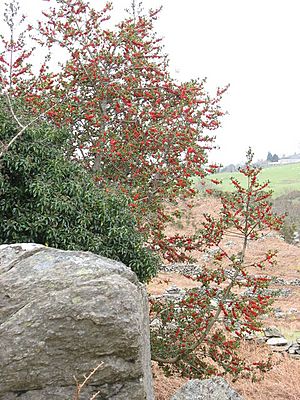
Holly and ivy in Wales
|
|
| Genre | Christmas carol |
| Text | English traditional carol |
| Meter | 7.6.8.6 with refrain |
The Holly and the Ivy is a classic British Christmas carol. It's a traditional folk song that has been sung for a long time. This song is listed as number 514 in the Roud Folk Song Index, which is a huge list of folk songs.
The song's history goes back to the early 1800s. However, the idea of linking holly and Christmas is much older. People have been doing this since the medieval times.
Over the years, the words and tune of the song changed a lot. This happened as different communities sang it. But eventually, one version became the most popular. This well-known version was found in 1909. It was collected by Cecil Sharp, an English folk song expert. He heard it from a woman named Mary Clayton in Chipping Campden, Gloucestershire, England.
Contents
Song Lyrics
Here are the words of the song. They come from Cecil Sharp's book, English Folk-Carols, published in 1911. This book helped make these words and the tune famous.
|
1. The holly and the ivy, |
4. The holly bears a prickle, |
Song's History
The words of "The Holly and the Ivy" first appeared on special printed papers. These papers were called broadsides. Three of these broadsides were printed in Birmingham in the early 1800s.
One of the first times the song's title was mentioned was in 1823. This was in a book by William Hone called Ancient Mysteries Described. He listed "The holly and the ivy, now are both well grown" among other Christmas carols.
The full words of the carol were found in a book review from 1849. The reviewer suggested using the carol's words instead of other readings. They mentioned that many simple religious songs, like carols, were popular in England. Many of these songs were only passed down by singing them.
Later, in 1861, the words were included in Sylvester's book, A Garland of Christmas Carols. He said the song came from an "old broadside" printed around 1711. Husk's book in 1864 also included the carol. He noted that it was still being printed on broadsides in Birmingham.
Different Versions
Many different versions of "The Holly and the Ivy" have been found. These were collected from traditional singers. Early printed versions also show differences from the popular song we know today.
One common traditional version was called "The Holly Bears a Berry". The more familiar "The Holly and the Ivy" was sung with various tunes and words. This shows how folk songs can change over time.
The Music
Standard Melody
The tune we usually hear for "The Holly and the Ivy" was first printed in 1911. This was in Cecil Sharp's book, English Folk-Carols. Sharp wrote that he heard the tune from Mrs. Mary Clayton. She lived in Chipping Campden, a lovely town in the Cotswolds.
Sharp wrote down the music as Mrs. Clayton sang it on January 13, 1909. His notes are kept safe at Clare College, Cambridge. You can even see them online! This melody is special because it only uses notes from a hexachord, which is a group of six notes.
\new Staff << \time 3/4 \key g \major \partial 4 \relative c { \set Staff.midiInstrument = #"flute" \autoBeamOff
g4Other Tunes
People have sung the words of "The Holly and the Ivy" to many different folk tunes. For example, three other tunes were found just in Gloucestershire. You can even find recordings of these different melodies. One was sung by Peter Jones from Ross-on-Wye, Herefordshire. Another was by Bessie Wallace from Camborne, Cornwall, recorded in the 1930s.
The "Sans Day Carol" is thought to be a version of this song. It has its own unique tune. Older sources from the 1800s don't include music for the carol. But some later collections from the late 1800s used an "old French carol" tune for the words.
Cultural Meaning
Holly, especially the kind found in Europe, is often seen around Christmas time. It's sometimes even called Christ's thorn. Since the Middle Ages, holly has had a special Christian symbolism. This is shown in "The Holly and the Ivy" carol. In the song, holly stands for Jesus, and ivy represents His mother, the Virgin Mary.
Angie Mostellar explains the Christian meaning of holly at Christmas:
- The sharp leaves remind us of the crown of thorns Jesus wore.
- The red berries make us think of the drops of blood He shed for our salvation.
- The shape of the leaves looks like flames, showing God's strong love for people.
Holly also stays bright green during the Christmas season. This is why it became connected with the Christian holiday. Holly and ivy have been popular decorations in British churches since the 1400s and 1500s.
Holly and ivy are also mentioned in the lyrics of the "Sans Day Carol". Sir Henry Walford Davies created a popular choir version of "The Holly and the Ivy". It's often sung at the Festival of Nine Lessons and Carols. Even Henry VIII wrote a love song called Green Groweth the Holly. This song talks about holly and ivy staying green through winter.
William Hone's 1823 book also mentions an old manuscript from the British Museum. This manuscript has a song about holly and ivy. It starts with these lines:
Nay, my nay, hyt shal not be I wys,
Let holy hafe the maystry, as the maner ys:
Holy stond in the hall, faire to behold,
Ivy stond without the dore, she ys ful sore acold,
Nay, my nay etc
"The Holly and the Ivy" is also linked to an older carol. Cecil Sharp called it "The Contest of the Ivy and the Holly". This song describes a friendly competition between ivy (representing women) and holly (representing men).
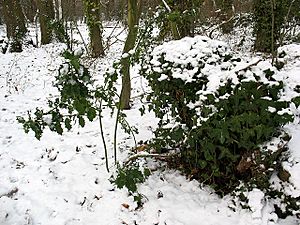
Holly stands in the hall, fair to behold:
Ivy stands without the door, she is full sore a cold.
Nay, ivy, nay, it shall not be I wis;
Let holly have the mastery, as the manner is.
Holly and his merry men, they dance and they sing,
Ivy and her maidens, they weep and they wring.
Nay, ivy, nay, etc
Ivy hath chapped fingers, she caught them from the cold,
So might they all have, aye, that with ivy hold.
Nay, ivy, nay, etc
Holly hath berries red as any rose,
The forester, the hunter, keep them from the does.
Nay, ivy, nay, etc
Ivy hath berries black as any sloe;
There come the owl and eat him as she go.
Nay, ivy, nay, etc
Holly hath birds a fair full flock,
The nightingale, the popinjay, the gentle laverock.
Nay, ivy, nay, etc
Good ivy, what birds hast thou?
None but the owlet that cries how, how.
Nay, ivy, nay, etc
Recorded Versions
Many artists have recorded "The Holly and the Ivy". Here is a list of some of them:
- 1958: Petula Clark on her EP A Christmas Carol
- 1969: The Young Tradition on The Holly Bears the Crown (released in 1995)
- 1972: Steeleye Span as the B-side of their single Gaudete
- 1982: George Winston (instrumental) on December
- 1985: Yes singer Jon Anderson on 3 Ships
- 1986: Choir of St John's College, Cambridge on Christmas Carols from St. John's
- 1987: Maddy Prior with The Carnival Band on A Tapestry of Carols
- 1988: Mannheim Steamroller (instrumental) on A Fresh Aire Christmas
- 1991: Therese Schroeder-Sheker - In Dulci Jubilo
- 1994: Natalie Cole - Holly & Ivy
- 1997: Roger Whittaker in his album Happy Holidays from Roger Whittaker
- 2003: Mediaeval Baebes on Mistletoe and Wine and again in 2013 on Of Kings And Angels
- 2004: Andrew Peterson (instrumental) on Behold the Lamb of God
- 2008: Sound of the Rockies - Sing We Noel
- 2008: Loreena Mckennit on A Midwinter Night's Dream
- 2008: Kate Rusby on Sweet Bells
- 2010: Annie Lennox on A Christmas Cornucopia
- 2011: Hawk Nelson on the EP Christmas
- 2014: Deborah Voigt and the Mormon Tabernacle Choir - Let The Season In
- 2014: Los Campesinos! on their Christmas EP A Los Campesinos! Christmas
- 2017: Ola Gjeilo performed by Choir of Royal Holloway on their album Winter Songs


